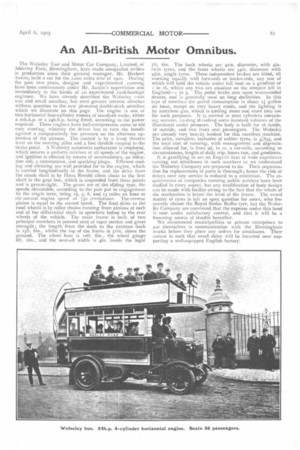An All-British Motor Omnibus.
Page 9

If you've noticed an error in this article please click here to report it so we can fix it.
The WolseleyTool and Motor Car Company, Limited, of Adderley Park, Birmingham, have made unequalled strides in production since their general manager, Mr. Herbert Austin, built a car for the I,cioo miles trial of 1900. During the past two years, designs and experimental running have been continuously under Mr. Austin's supervision and immediately in the hands of an experienced road-haulage engineer. We have already described the Wolseley 1-ton van and small omnibus, but even greater interest attaches without question to the new 36-seated double-deck omnibus which we illustrate on this page. The engine is one of two horizontal four-cylinder motors of standard make, either a 2ob.h.p. or a 24b.h.p. being fitted, according to the power required. These engines have half-compression cams to aid easy starting, whereby the driver has to turn the handle against a comparatively low pressure on the alternate upstrokes of the pistons. The control is by a hand throttle lever on the steering pillar and a foot throttle coupled to the brake pedal. A Wolseley automatic carburetter is employed, which secures a uniform mixture at all speeds of the engine, and ignition is effected by means of accumulators, an induction coil, a commutator, and sparking plugs. Efficient coolingand silencing are well provided for in the engine, which is carried longitudinally in the frame, and the drive from the crank shaft is by Hans RenoId silent chain to the first shaft in the gear box, which is suspended from three points and is grease-tight. The gears are of the sliding type, the speeds obtainable, according to the pair put in engagement by the single lever, being 2, 5, 8, and 13 miles an hour at the normal engine speed ot 750 revolutions. The reverse pinion is equal to the second speed. The final drive to the road wheels is by roller chains running from pinions at each end of the differential shaft to sprockets bolted to the rear wheels of the vehicle. The main frame is built of two principal members in pressed steel of taper section and great strength; the length from the dash to the extreme back is t5ft. 6in., whilst the top of the frame is 1in. above the ground. The wheel base is 'oft. 6in„ the wheel gauge 61t. 21n., and the over-all width is kin. inside the legal
7ft. 6in. The back wheels are 42in. diameter, with 4in. twin tyres, and the front wheels are 34in. diameter with 4iin. single tyres. Three independent brakes are fitted, all working equally well forwards or backwards, any one of which will hold the vehicle under full load on a gradient of
in 16, whilst any two are absolute on the steepest hill in England-1 in 5. The pedal brake acts upon water-cooled drums, and is generally used on long declivities. In this type of omnibus the petrol consumption is about i gallon an hour, except on very heavy roads, and the lighting is by acetylene gas, which is coming more and more into use for such purposes. It is carried in steel cylinders containing acetone, tio.ding dinsolved some hundred volumes of the illuminant under pressure. The body is built for i6 inside, 18 outside, and two front seat passengers. The Wolseley ara already very heavily booked for this excellent machine. The price, complete, inclusive of rubber tyres, is ;6855, and the total cost of running, with management and depreciation allowed for, is from od. to is. a car-mile, according to circumstances, length of daily trip, hours run, and gradients.
It is gratifying to see an Eng-i,sh firm of wide experience turning out omnibuses in such numbers as we understand the Wolseley Company are prepared to do. Their organisation for replacements of parts is thorough; hence the risk of delays over any service is reduced to a minimum. The requirements of companies running public services have been studied in every aspect, but any modification of body design can be made with facility owing to the fact that the whole of the mechanism is below the level of the frame. The vexed matter of tyres is left an open question for users, who frequently choose the Royal Sirdar Buffer tyre, but the Wolseley Company are convinced that the expense tinder this head is now under satisfactory control, and that it will be a lessening source of trouble hereafter.
We recommend municipalities or private enterprises to put themselves in communication with the Birmingham works before they place any orders for omnibuses. Their output is such that small delay will be incurred over supporting a well-equipped English factory.




















